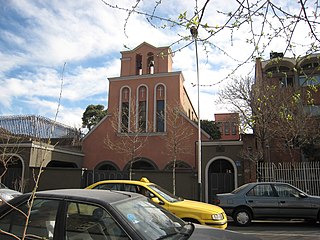Related Research Articles

Christianity in Iran dates back to the early years of the religion during the time of Jesus. Through this time the Christian faith has always been followed by a minority of the population of Iran under its different state religions: Zoroastrianism in historical Persia, followed by Sunni Islam in the Middle Ages after the Arab conquest, then Shia Islam since the Safavid conversion of the 15th century. However, Christians comprised a larger share of the population in the past than they do today. Iranian Christians have played a significant part in the historical Christian mission: currently, there are at least 600 churches and 300,000–370,000 converts.

Urmia is the largest city in West Azerbaijan Province of Iran. In the Central District of Urmia County, it is capital of the province, the county, and the district. The city is situated near the borders of Iran with Turkey and Iraq.

Sadegh Hedayat was an Iranian writer, poet and translator. Best known for his novel The Blind Owl, he was one of the earliest Iranian writers to adopt literary modernism in their career.

Lake Urmia is an endorheic salt lake in Iran. The lake is located between the provinces of East Azerbaijan and West Azerbaijan in Iran, and west of the southern portion of the Caspian Sea. At its greatest extent, it was the largest lake in the Middle East. It is the sixth-largest saltwater lake on Earth, with a surface area of approximately 6,000 km2 (2,300 sq mi), a length of 140 km (87 mi), a width of 70 km (43 mi), and a maximum depth of 20 m (66 ft).

The Sayfo, also known as the Seyfo or the Assyrian genocide, was the mass murder and deportation of Assyrian/Syriac Christians in southeastern Anatolia and Persia's Azerbaijan province by Ottoman forces and some Kurdish tribes during World War I.

Dār ul-Funun was an institute of higher education in Iran. It was established in 1851 by Amir Kabir, the grand vizier to Nasereddin Shah.
Iranian Armenians, also known as Persian Armenians, are Iranians of Armenian ethnicity who may speak Armenian as their first language. Estimates of their number in Iran range from 70,000 to 500,000. Areas with a high concentration of them include Tabriz, Tehran, Salmas and New Julfa, Isfahan.

Assyrians in Iran, or Iranian Assyrians, are an ethnic and linguistic minority in present-day Iran. The Assyrians of Iran speak Assyrian Neo-Aramaic, a neo-Aramaic language descended from the eastern dialects of the old Aramaic language with elements of Akkadian, and are Eastern Rite Christians belonging mostly to the Assyrian Church of the East and also to the Ancient Church of the East, Assyrian Pentecostal Church, Chaldean Catholic Church and Assyrian Evangelical Church.

The Catholic Church in Iran is part of the worldwide Roman Catholic Church, under the spiritual leadership of the Pope in Rome.

Assyrians in Armenia make up the country's third largest ethnic minority, after Yazidis and Russians. According to the 2011 census, there are 2,769 Assyrians living in Armenia, and Armenia is home to some of the last surviving Assyrian communities in the Caucasus. There were 6,000 Assyrians in Armenia before the dissolution of the Soviet Union, but because of Armenia's struggling economy during the 1990s, the population has been cut by half, as many have emigrated.
Paul Bedjan was an Assyrian priest of the Chaldean Catholic Church and a Syriacist and orientalist.

The Roman Catholic Archdiocese of Tehran–Isfahan is a jurisdiction of the Catholic Church in Iran.

Gholām-Hossein Sā'edi MD was a prolific Iranian writer.

Doulab Cemetery is a historical cemetery situated in the eastern suburbs of Tehran, Iran. One of the most important Christian cemeteries, it consists of five sections:

Maxime Feri Farzaneh was a French-Iranian writer and filmmaker. He signed his books "M.F. Farzaneh" and his films "Feri Farzaneh".

Jeanne d'Arc School was a prestigious French school for girls founded in 1900 in Tehran, Iran. It operated until the 1979 Islamic Revolution. Many members of Iran's upper classes sent their daughters to the Jeanne d'Arc School, and it offered both primary and secondary education. French and English were taught as foreign languages at the Jeanne d’Arc School.
She'r-e Nimaa'i is a school of Modernist poetry in Iran that is derived from the literary theory of Nima Yooshij, a contemporary Iranian poet. Nima Yooshij revolutionized the stagnant atmosphere of Iranian poetry with the influential poem Afsaneh, which was the manifesto of She'r-e Nimaa'i. He consciously challenged all the foundations and structures of ancient Persian poetry. The nature of Mazandaran, social criticism, and humor are just a few examples of the themes that Nima Yooshij used in his poems. She'r-e Nimaa'i was the source of inspiration and growth of many great modern Iranian poets, including Sohrab Sepehri, Forough Farrokhzad, Mehdi Akhavan-Sales and Fereydoun Moshiri.
Christian Urmi is the dialect of Northeastern Neo-Aramaic spoken by Assyrian Christians in Urmia, northwestern Iran.
References
- ↑ A brief history of the Lazarist mission in Iran and the Jeanne d’Arc School of Tehran
- ↑ A History of Literary Criticism in Iran, 1866-1951:
- ↑ FRANCE xv. FRENCH SCHOOLS IN PERSIA
- ↑ مدرسه سن لوئی تهران
- ↑ Tehran (Iran): Jeanne d'Arc School: Group
- ↑ My old stomping ground
- ↑ In Tribute To Père Toulemonde
- ↑ Vaziri, ʿAli-Naqi
- ↑ "محمود بهارمست". Rasekhoon. Archived from the original on 10 January 2022. Retrieved 10 January 2022.